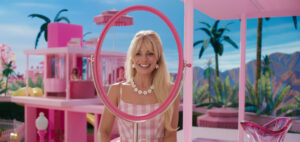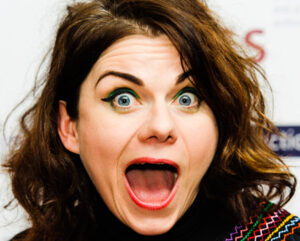Before Ty Warner became the billionaire architect of the notorious Beanie Babies bubble, he was minor royalty in the niche world of plush toys. His big innovation, unique at the time, was a line of Himalayan cats that were under-stuffed to make them floppier, and hence more poseable. “Fifty poses for the head alone!” bellows Zach Galifianakis, who plays Warner in new film The Beanie Bubble, which tracks how, for five magical years in the late Nineties, an obsessed public turned miniature stuffed animals into the hottest investment commodity around.
Beanie Babies were designed to be a child’s plaything. About the size of a human hand and made to look like animals — although there was the occasional seasonal ghost or pumpkin or snowman — each character came with a heart-shaped “Ty” tag with a bespoke poem inside. That tag became an avatar for the evolving role of Beanie Babies in American culture; as a secondary market began to boom on sites like eBay, a mint condition Beanie with its authentic tag still in place fetched the highest price.
Beanie Babies followed the trajectory of other collectible crazes from the Eighties and Nineties — baseball cards, Hummel figurines, Pokémon — but their rise was stratospheric by comparison, and, eventually, a whole lot more embarrassing. The Beanie Baby Bubble was not just a significant moment in American consumer history but also a uniquely shameful one. The divorcing couple dividing their Beanie collection on the floor of a Vegas courtroom; the drivers brawling for Beanies on a freeway after a Ty truck tipped over and spilled its contents; the petty criminal who went to prison after killing someone in a Beanie Baby buy gone wrong: these incidents say a lot about our country, and our culture, none of it flattering.
Perhaps this is why The Beanie Bubble seems so ambivalent about the man responsible for the national shame of Beanie mania — and so torn on the question of how responsible he actually was. A central paradox of this story is the view it takes of Warner, who it wants to at once blame for inflicting Beanie Babies on us, while also undermining his claims to having made them a success. Was Ty Warner the evil architect behind the bubble, or a bumbling man-child whose greatest talent was stealing the ideas of the more intelligent women with whom he partnered professionally, as well as, often, romantically?
About two-thirds of the way through, one gets the distinct sense that the film views its central subject with what can only be described as complete and total contempt. The middle-aged Warner is discovered weeping, on the floor, in the dark, by Sheila, his bewildered fiancé (played by Sarah Snook). Ty is supposed to become a stepfather to her daughters — but he’s having an existential crisis. “I can’t be a parent. I’m the child. I need to be taken care of,” he sobs, and collapses with his head in her lap. “Hold me like I’m a little boy!”
Sheila acquiesces, grimacing all the while. She’s completely revolted — as are we, the audience — and yet, also sort of empowered. Who really has the upper hand here: the middle-aged man having a blubbering meltdown, or the woman looking down at him as if a large slug had just crawled into her lap?
The filmmakers can’t seem to decide — or perhaps more accurately, have chosen a framework for Warner’s story that makes it impossible to know. In this way, it’s of a piece with the contemporary trend for retelling a familiar story through a feminist, or at least female, lens; think Six, the smash-hit musical which emphasises the agency of Henry VIII’s six wives, or the storylines from Hamilton told through the eyes of the women who loved him. The Beanie Bubble assembles a cast of women who operated in Warner’s orbit — the business partner and girlfriend with whom he first founded the Ty corporation; the young assistant who proved to be a whiz-kid pioneer of online marketing; the single mother whose daughters inspired and helped design the first line of beanie babies — and makes them the film’s narrators. According to The Beanie Bubble, every innovation that made Beanie Babies such a wild success was to some degree either inspired by or stolen from one of these women.
In a moment when our culture is so preoccupied with identitarian “centring” of marginalised characters over privileged ones, it’s not hard to see why storytellers like this tactic. The feminist reframe of a familiar tale is cheaper and easier than coming up with something new and original: Ghostbusters, but with ladies! It can even seem radical and empowering, as long as you don’t think about it too hard. As long as you don’t notice that the active ingredient in these allegedly feminist narratives is often, you know, a man.
As for this movie’s central man, he’s at once loathsome and pathetic, more worm than snake. Galifianakis portrays him as paranoid and grasping but also oddly effete. He’s as obsessive about his own appearance as he is about coiffing and tweezing the technicolour fur of the stuffed Himalayan cats that were his inaugural product; his insatiable desire for plastic surgery is a recurring punchline. Maybe the idea here was to highlight Warner’s belief in the power of self-reinvention — “The number one thing about America is, it’s the land of comebacks,” he says early on — but the whole presentation is so campy, so obviously played for laughs, that it comes across as a suggestion that a truly manly man cannot possibly be interested in fake fur and facelifts. If there’s a feminist lens to be found here, it’s from that strain of feminism that seeks to avenge all the women who chafed at traditional gender roles by levying equally harsh judgment against the men who do the same: more a reinvestment in patriarchy than the subversion thereof.
Perhaps more importantly, though, making a sad, incompetent clown of Warner relieves him of agency for his misdeeds in a way that he probably doesn’t deserve. It’s interesting here to compare the onscreen version of this man to the one in The Great Beanie Baby Bubble, the exhaustively researched book by journalist Zac Bissonnette on which the film was based. In real life, Warner was both a more complex figure and also a darker one: he was, and by all accounts still is, a deeply broken person who couldn’t be made happy by enormous professional success, a man ruled by insecurities that made him less ridiculous than monstrous.
When the movie departs from its source material, what it leaves out is as important as what it includes. That “hold me like a little boy” moment is in the book; it happened more or less as depicted. But another scene, in which Warner’s co-founder discovers that he’s bugged her office to spy on her, waters down what was in reality a pretty horrifying incident. Warner actually bugged the woman’s house, after one of their breakups — and, years later, tormented her with the audio recordings he’d made of her having sex with another man. There’s little question that this mercurial, egomaniacal, manipulative man was possessed of both the talent to create the Beanie Baby craze and the capacity to use it for evil.
Of course, that would be a pretty sinister turn for a movie whose entertainment value derives mainly from watching Zach Galifianakis strut around like the deranged Willy Wonka of all things plush and poseable. And of course, audiences aren’t especially receptive these days to morally complex films or characters, especially when those characters never do suffer much in the way of externally-imposed consequences for the various harms they caused. (Warner was convicted of tax evasion in 2014, but received no prison time; today, he’s still worth upwards of $2.3 billion.) It’s not hard to see why the Beanie Bubble would opt to portray its main character as a flamboyant man-child rather than as a calculating abuser — or, for that matter, why filmmakers would side-line Warner in the story of his own life, in favour of creating a satisfying albeit shallow fable of female empowerment.
But the truth about Ty Warner and the women he loved (or didn’t, as the case may be) is bleaker, messier, and far more compelling than a made-for-Hollywood narrative allows. Which brings us back to Sheila, whose real name was Faith McGowan. In the movie, that moment when he sobs on her lap in the dark is the beginning of the end. In the movie, she never allows her feelings for Warner to compromise her autonomy. And in the movie, when he betrays her, she not only leaves him, but makes off like a bandit, selling a bunch of discontinued Beanie Babies right before the bubble bursts.
In real life, on the other hand, Faith McGowan died in 2013, leaving behind a home that was, as described in The Great Beanie Baby Bubble, like a shrine to Warner. There was a glass bookcase full of Ty plush toys prominently displayed. She spent the rest of her life clinging to the memories of the man she almost married; he seems to not have thought about her much at all.
Did the filmmakers give her a better ending? By some standards, yes. It’s certainly more fun this way, to trade the complex reality of Warner’s character for an entertaining caricature, and the ordinary tragedy suffered by McGowan — who, unlike her infuriatingly sensible Hollywood avatar, couldn’t reason her way out of loving a man who was bad for her — for a rote fantasy of female empowerment. But not only is the ending not true, there’s something about the way in which it’s not true that feels a little sleazy. A little cheap. A little bit designed to prey on the human yearning for quick and easy satisfaction. Much in the way that Ty Warner and his Beanie bubble did.
Disclaimer
Some of the posts we share are controversial and we do not necessarily agree with them in the whole extend. Sometimes we agree with the content or part of it but we do not agree with the narration or language. Nevertheless we find them somehow interesting, valuable and/or informative or we share them, because we strongly believe in freedom of speech, free press and journalism. We strongly encourage you to have a critical approach to all the content, do your own research and analysis to build your own opinion.
We would be glad to have your feedback.
Source: UnHerd Read the original article here: https://unherd.com/



